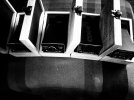Hi, is it possible to bring the level up to -5dBFS in the second test, like in the first one?
Unless I've missed something, it would be better to compare to get the same level at the ADC input.
I should be clearer, perhaps.
The output of the test generator is exactly the same. The output of the Scaler is exactly the same. Those weren't touched. But, by running the output of the Scaler through the notch filter of the Cosmos APU, the level of the 1 KHz fundamental tone into the ADC is reduced, with the harmonics mostly unaffected. That minimizes the distortion added by the ADC, so we just see the distortion coming from the generator.
There's way more here: Archimago on the APU
His results are similar, mostly. He used a slower sampling rate for the ADC, which would lower the noise a bit. He also had his ADC internal attenuator set differently. Plus, some of his measurements settings are different. I didn't even try to match what he did. I just wanted to do a with-APU and without-APU comparison. Also note that his generator (same as mine) is not in a shielded box and he also uses a somewhat different powering scheme which I found reduces performance a bit.
Later on, he optimized his generator to get similar results to mine: Archimago improves his generator performance
Last edited:

